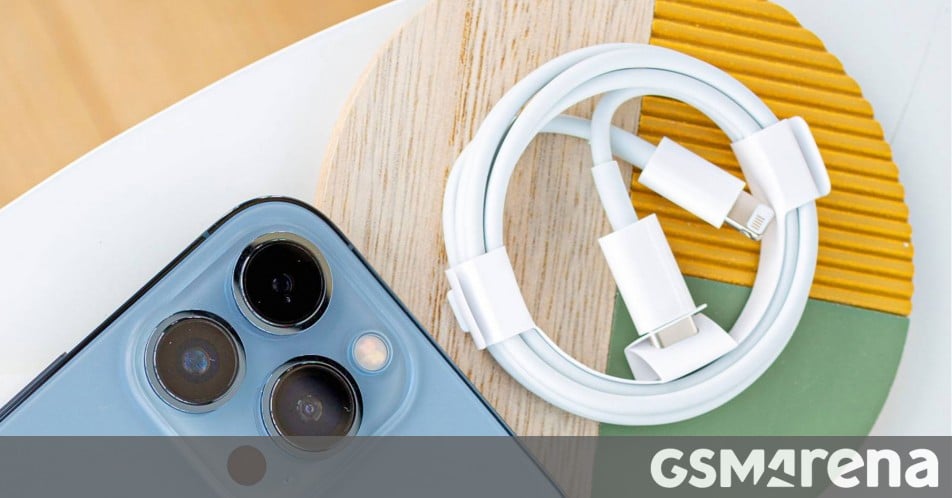And people will be dismembered if they fail to comply.
Well that’s handy, because thanks to the EU that’s what everything will be using anyway.
What else are they going to mandate? That sand remains course and irritating? Or more likely demand that the rest of the world stops laughing at their Jetsons city idea.
This goes way further than EU rules.
EU regulation only mandates this for phones. This also covers non-phone electronics, such as mice, keyboards, flashlights, handheld fans, ebooks etc. As of 2026, it also applies to laptops.
No, that’s EXACTLY the EU regulation too. Up to and including the 2026 exception for laptops.
I didn’t look into every little detail. But EU’s regulation certainly is not only for phones.
Saudi sand actually isn’t course enough
Removed by mod
This will just lead to increased popularity of wireless charging
I still haven’t found a good reason to ever use wireless charging, feels like a gimmick to me Wire is just more convenient.
In order to charge my phone wirelessly, I have to take it out of the case. Which is a bigger pain than just plugging a wire into it.
I actually use wireless charging at night. They way I see it is in cutting down on the wear on my charging port. Plus, the slightly slower charge speeds are probably better for my battery long term
Cutting wear of is fair point. Fast charging can be disabled if wanted with wired charging so that is not issue. Because of wireless charging, the backlid has to be glass, which is annoying cause it breaks more easily.
The back lid doesn’t have to be glass, my iPhone 14 pro has a metal back and wireless charging works fine
I stand corrected
Might be worse for the battery because of increased heat but idk
We’ve hit peak QI, almost.
Even Kindles have it now. Watches, phones, like 4 brands of earbuds I tested the other day (testing power share from the older samsungs), etc.
The only thing that doesn’t have it in our house is my oura ring, which as a G2 is the last one I want to buy from what that company has become, so it’s going to solve itself soon.
The only time I’d even use wireless charging is when I’m in bed. Any other time I need to be able to use my phone when it’s charging.
MagSafe battery and all other MagSafe accessories🤷🏻♂️. I charge exclusively by MagSafe aka wireless.
It seems like a good idea to have it built into a nightstand or built into your desk so your phone charges when you put it down. In practice you have to place the phone down in a very specific spot on the charger for it to work, so it’s hardly more convenient than a cable.
Government mandates electronics sounds very Communist. I thought were way past that already. Companies should be allowed to compete for charging standards without government interference. Let the invisible hand of capitalism self correct itself, though the heavens fall.
Yes, every government regulation is communism. No dangerous lead levels in drinking water, gasoline, etc.? Communism. Companies should be allowed to compete for lead level standards without government interference. Let the invisible hand of capitalism correct itself.
Yeah well the markets had plenty of time to regulate itself it hasn’t bothered to do so mostly because it contains Apple. Not every piece of government oversight is communism.
True… companies can come up with their charging standards. Just don’t try to sell it in all of EU or Saudi Arabia. Also apple overcharged for the damn cables and they break so quickly. last time I used iphone the cable was 20 euro. While I could buy 20 USB-C cables for that. Never had a broken USB-C cable. not even the ones for AliExpress
Removed by mod
deleted by creator
Not that a new connector is around the corner, but I love how people try to act like this will be an achilles heel for these laws. How long will it take to vote in an amendment that updates the connector?
I get it, being anchored to one connection type sounds good now while it’s still somewhat new, but in 10 years it could be a burden. Still, I do not want to go back to the days of every device having a unique barrel connector.
Many people have been taught regulation is bad, not much logic to it.
USB-C as a connector can easily last a decade, much longer for just power delivery.
Exactly! Most electronics are surprisingly low-powered, but USB-C can currently support 100W with a draft spec with upwards of 240W. We’ll be fine for awhile.
Yeah, USB-C is fine for even mid-grade laptops. Realistically, if your device is using more than 100W then it probably has an IEC plug (or at least, an in-line power brick with an IEC port) instead. Pretty much the only thing USB-C isn’t suitable for currently is gaming laptops, because those easily draw upwards of 200W.
They arent suitable for gaming laptops while gaming. They are fine enough to just charge during light/no usage at somewhat reduced speeds.
The USB-C EPR spec allows for 230W charging.
The Framework 16 releasing later this year will be the first laptop to use the spec with a 180w power supply
Kind of nuts to me to be putting anything 200W up anywhere near my butthole
USB-PD 3.1 standardized EPR in 2021; it hasn’t been draft for a while.
I’d be surprised if USB-C was a limitation on phone technology even by 2040. The bandwidth and power delivery capacity are way beyond what are needed now. Data transfers from phones are going to increasingly move to wireless in that time frame too, I expect.
The limitation on the viability of USB-C with phones won’t be the actual technological viability of the standard with respect to phones. Instead, the problem for USB-C for phones will be if another standard comes out and starts being used by other devices that do need higher bandwidth or power delivery capability. Monitors, storage devices, laptops (etc.) will eventually need more than USB-C can provide, even with future updates to its capacity. When those switch over to something new, that will be when phones (and other devices) will need to consider a new standard too.
Usb 1.1 came out in like 1994, I still use it for keyboards and mice, ie the main thing I plug in to my pc. USB 2.0 came out around 1999, that covers most everything else.
Usb 3 is from 2009 or so, most of us don’t bother with them except for storage because they’re overspecced otherwise and usb 2 is cheaper.
Usb 4 will be fine in 2040 unless something weird happens, we’ll still be using usb 2.0 because the cables are cheaper and more flexible than 3.0, we’ll just call it “USBx4.2 base profile”
Remember what we said and acted on 20 years ago about technology? Yeaaahh…That’s what you said right now.
This is speculation based on the combination of physical constraints and changing usage.
Phone batteries today are in the 10-20 watt-hours range for capacity, or at least iphones are and that’s the data I found. Going from the typical ~20W fast charging rate to the full 240W capacity of USB-C EPR would allow a twelve times increase in battery capacity with no change to charge times. Are batteries going to increase in capacity by twelve times in the next 17 years? I’d be shocked if they did. The change from the iphone 1 to the iphone 14 pro max is 5.18Wh to 16.68Wh — a three times increase in 16 years.
Likewise, with data transfer, it’s a matter of how human-device interaction has shifted with time. People increasingly prefer (a) automated, and (b) cloud based data storage, and (c) if they do have to move data from device 1 to device 2, they would rather do it wirelessly than with a physical connection. USB4 on USB-C is meant for 80 Gbit/s = 9.6 GB/s transfers. That’s already faster than high end SSD storage can sustain today, and USB4 is a four year old standard. People on phones are going to be far more likely to be worried about their wifi transfer speeds than their physical cable transfer speeds, especially in 2040.
Then, on top of all of that… USB will continue to be updated. USB-C’s limitations in 2033 will not be USB-C’s limitations in 2023, just as USB-C’s limitations in 2023 are not the same as USB-C’s limitations at its inception in 2014. In 2014 USB’s best transfer rate was 10 Gbit/s, or 1/8 what it can do today.
USB4 is actually faster than DisplayPort 2.1 and I don’t think we’ll go past 8k at 165Hz any time soon. When it comes to storage at some point you really want an SFP port currently maxing out at 400Gbit (as opposed to USB4 120Gbit, and that’s asymmetric). For reference: You need to drive the NIC with PCIe 5x16 to saturate that. Unidirectionally. Network speeds are nuts you need specialised hardware to keep up with the cables.
Laptops why yes that’s what USB is for.
deleted by creator
I collect old handhelds. Each one having a unique charging and/or sync cable fuckin sucks and I’m so glad that USB is ubiquitous. My current daily driver has mini USB for data, but charges using a unique connector that plugs into a unique cradle that sends power to the device when hooked into the cradle. Without the cradle, ya ain’t charging this thing.
EU version has review process built-in. Anyways it’ll be hard to get more outdated than lightning.
Well USB-C was published 9 years ago, and has been well-established, nearly ubiquitous for at least 5. Why did this take so long?
This is my first thought when it comes to legislation like this. My representatives in government are the last people I would confer with when it comes to technology, so I don’t think they should pick phone charger standards.
How long will it take to vote in an amendment that updates the connector?
Depends on what corporations and countries are backing it probably.
I thoroughly agree the connector insanity was a pain in the ass (though, being a hoarder of cables it made me a sort of superhero) but I just really dislike governments dictating this kind of thing.
USB-C is a connector shape, so there’s really no need for a USB-D. What you’re thinking of is USB 5.0, except the USB has a penchant for coming up with the dumbest names imaginable. The current latest (I think) version is 3.2 Gen 2x2, so the next major version will probably be called some bullshit like USB 3.2 Gen 2x2+1.
deleted by creator
How immature.
Regardless, I have to say:
Gottem.
deleted by creator
deleted by creator
USB One
Usb1 series 3
USB4 is here and is already being called weird stuff.
USB 3.2 Gen 2x2+1.
Thankfully it’s not the 90s or they’ve called this “USB 3.2 Gen 2x2 Extreme”
Wikipedia lists USB4 Gen 4 (No space between USB and 4, which is different from previous versions which did have a space there).
Following USB4 Gen 2×1, USB4 Gen 2×2, USB4 Gen 3×1 and USB4 Gen 3×2.
okay nerd
If the USB-IF can agree on it, why not?
The USB-IF moves so slowly it might as well be standing still.
I think it’s good for USB standards to move slow.
Finally just about every device I buy has USB-C now. If they release a new connector that’ll just mean using 2 different cables for everything again.
Prince ibin-whateverface is an Android user and finds lightning annoying. That’s all this says to me. He’s not wrong, btw. For once.
See? This is how you should use your authoritarian powers
There is a second stage, starting from April 1, 2026, which will apply to laptops and portable computers.
I’m with them on small devices using USB C, but all laptops is a pretty tall task. Can gaming laptops that need a high voltage even use USB-C? They already struggle with massive charging bricks and thick cables.
The latest USB power delivery standard allows for new voltages of 28, 36, and 48 volts at up to 240 watts at 48V. My current Dell workstation laptop uses two 20V USB C connectors to achieve similar.
I’m imaginining some kind of monstrosity of a gaming laptop with a power cable that looks like a hydra splitting into three or four USB-C connectors, and it’s gloriously silly.
Maybe it’s time for a new thing similar to USB 3.0 micro B, with two USB-C connectors next to each other on the same plug.
Pretty much, they magnet together though so you can split them apart and use them as normal with other devices.
There are already laptops with docking stations that take 2 USB-C connectors. Annoyingly, the docking stations come with a Franken-connector of 2 USB-C plugs in one solid plastic housing so you can only use the dock with a specific laptop.
It would make since to say something like usb-c is required for up to x volts. Then x-y volts require this other kind of charger.
I mean it’s totally valid if the required technology literally can’t handle certain applications that there needs to a level 2, level 3, and onward option.
I’m chuckling at the idea of someone plugging in an early USB-C device and watching it go up in flames as it gets hit with 48v instead of the 5v that it’s rated for. I know USB-C has a chip that is supposed to negotiate power transfer, but it’s still a funny “what if” thought.
Not gaming (obviously!) but the2019 MacBook Pro has a 140W USB-C charger to a single port.
2019 is 96w charger. 140w is 2021 or later.
And isn’t the 140w reserved for the new MagSafe port?
I recently bought a gaming laptop. Specifically a Lenovo Legion 5 with a rx 6600. It has both the big powerbrick charger and can be charged via USB-PD, obv not at the same speed but it is an option that is available.
your gaming laptop is struggling because gaming laptops are scams. you’ll never get the performance you want and you’ll pay the premium anyways.
Probably. But your will have to buy the correct charger and cable. I have a couple 100W cables. The problem is they Al look alike.
The label maker business is about to be booming!
I specifically buy cables with different colors or from different brands as I upgrade, and keep a note around for what their PD capacity is for each set. It’s annoying, but doable.
i think some companies use seperate ports for charging and gaming on gaming laptops
the ASUS ROG STRIX SCAR 17, their biggest baddest gamiest 17" laptop, ships with a power adapter rated for 280W. it also offers charging over USB-PD at up to 240W, so would comply with the regulation here.
deleted by creator
Removed by mod
Removed by mod
Removed by mod
Removed by mod
Will this global push end up limiting miniaturization of electronics? Even if it does, may still be a worthwhile tradeoff.
It aims to eliminate waste by reducing the number of cords and plugs required for various devices. It will surely have to be upgraded and miniaturized as tech progresses, but for now it’s one everyone is agreeing on.
One aspect to consider for miniature devices is wireless charging. My watch and my headphones don’t even have a port
That would be clause 9: “It is also necessary to provide the basis for adaptation to any future scientific and technological progress or market developments, which will be continuously monitored by the Commission”
Common Saudi Arabia W
Let’s be real, they just want to have more of a reason to execute American iPhone-loving tourists 😂
The problem with these types of mandates is it locks us into standards and makes change hard. Imagine if they had done this when the terrible USB port was dominant.
Or, it gives all the power to the USB group. They have a terrible track record (USB-C is a mess).
The other problem is all the cheap devices that have a USB-C port, but will not charge from a real USB-C to USB-C cable. They are the same old USB ports electrically with a new shape.
These are bad laws with good intents.
Standards can be updated. Like the EU standard was from Micro-USB to USB-C. It happens all the time in all fields of technology.
How quickly will a standard be updated if the mandate encourages companies to entrench on the current standard? Industries built around the legislative certainty of the current standard may exert influence to inhibit moves to new standards, even if there are good reasons to move on.
What if we had mandated, by law, that all monitors must use the VGA connector in 1995? Would that have made DVI or HDMI or later technologies less likely to take off?
Suppose a company sees an opportunity for a better standard with such a law in place. They would have to develop the new standard and create the market for the new standard, all while their change is forbidden by law. How can they propose a new standard before actually developing it? Then, after sinking the costs on a hope, they would have to pay more to fight to change the law to encompass the new standard against everyone who likes it the way it is.
Don’t get me wrong. It would be neat if every doodad I had used the same connector. But soon enough, any connector we care to choose is a straitjacket. We raise the standard for improvement from being incremental and iterative to no change short of world shaking all at one go.
It’s locking nobody with no standard. The standard is evolving time to time. This argument of locking the user which by the way is the same as “competition is the better” is the Apple argument to impose it’s locked (walled garden) ecosystem.
It’s well known strategy to argue in a way that isn’t your goal to achieve another one. Apple is a master here. They use this same strategy with the future mandatory easy battery replacement.
I second this. How could anyone argue that regulation is bad for user? Standardization locks user in, what kind of logic is that?
I’m not sure about the SA one, but the EU variant of that law already has this thought through.
It has allowances already for new emerging standards. If USB-D came out, there would be zero law changes required.
always amazed by people who think “well, if we accept USB-C, we will never be able to have any future tech!” as if the regulation hasnt thought of that.
Which clause of the legislation provides for moving on to a new standard, short of new legislation?
That would be clause 9:
"It is also necessary to provide the basis for adaptation to any future scientific and technological progress or market developments, which will be continuously monitored by the Commission
God that last one drives me up a fucking wall. My partner’s laptop refuses to charge with anything except the officially supported power adapter, even though it’s just a USB-C connector. Everything I’ve plugged it into has been rated for the 100W that the laptop needs to charge, but the damned device locks out anything except official chargers under the guise of safety.
That should be illegal.
Nintendo Switch did/does the same
That’s because the Switch’s USB port isn’t actually a USB-C. Their port falls outside of the standard size/dimension specs, because they wanted the Switch to slide smoothly into the dock instead of having a positive click like a standard USB-C should.
This is why using a standard USB-C on your Switch can actually brick the device. Since the port is non-standard, the pins are much easier to accidentally short when plugging a standard USB-C into it. There was a big string of people complaining about bricked devices shortly after the Switch launched, and eventually players just learned to only use the official Switch chargers. But that’s only necessary because Nintendo told the USB-C standard to go fuck itself, and made a port that is almost the same (and will technically accept a standard USB-C port) but does everything slightly differently.
The Switch charger also has a power switching option, since the Switch draws more power when it’s docked than when you plug it in directly. So the power supply is set up to detect whether or not the dock is connected, so it can supply more power.
Unlike pretty much all other standards, all USB documents are open access and allow you to build compliant devices without 3rd party permission. You only need a license if you want to sell devices with the logo and/or need a official Vendor and Product ID (VID/PID). So unless all manufactures are forced to publish documentation for their IO in a similar level of detail, forcing one standard upon everyone is the next best option. Apple gambled on keeping their connector proprietary, and now get the backlash they deserve.


















